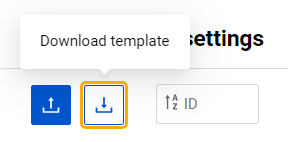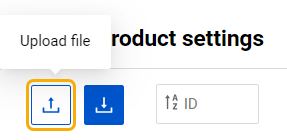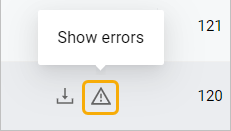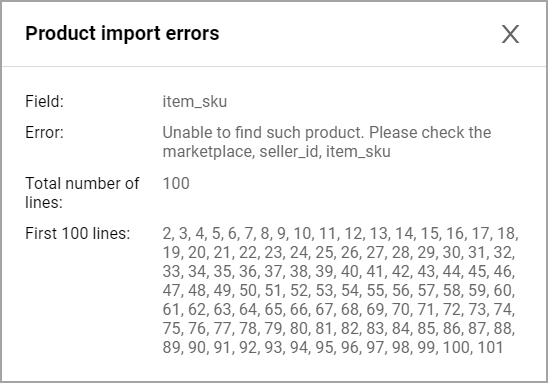The “Import product settings” page presents a table with a list of all import and bulk edit operations initiated by the users under your account on “Product costs”, “Import product settings”, or “Auto import product settings” pages. It also allows you to perform a manual import of the cost-related data to Business Analytics from external sources.
The “Import product settings” page can be accessed in two ways:
- SELLERLOGIC Homepage > Business Analytics | Import
- Business Analytics navigation bar > Import / Export > Import
Table fields
Below is a table listing all fields available on the "Import product settings" page, along with their respective descriptions.
| Column header | Description | Column header filter |
|---|---|---|
| ID | The unique identification number assigned to the import operation for reference and tracking purposes. | Live search |
| Created on | The date and time when the import was created. | |
| Import type |
The type of import operation performed. It can be one of the following:
|
Dropdown list |
| File type |
The type of import file being processed. The file type determines the data contained within the file. It can be one of the following:
|
Dropdown list |
| Status |
The current status of the import operation. It can be one of the following:
|
Dropdown list |
| Number of products | The total number of rows with data included in the import file. | Live search |
| Number of rows with errors | The number of rows with data in the import file that contain errors. | Live search |
| Number of imported rows | The number of rows with data that were successfully imported. | Live search |
| Start date | The date and time when the import operation was initiated. | |
| End date | The date and time when the import operation was completed. | |
| Updated | The date and time when the last change or modification was made to the import settings or file. |
Perform manual import
To perform the manual import of product settings data to Business Analytics, follow these steps:

Step 1: Initiate the download of the import template on your PC, by clicking the “Download template” button (down-arrow icon) located at the top left.
Step 2: From the “Select a template*” dropdown list, choose the appropriate template based on the data you intend to import and click “Download”:
- Product costs template: It is used to import the following product cost settings – SKU, Marketplace, Seller ID, Condition, Fulfillment method, ASIN, Title, Synchronize with Repricer, Cost of Goods (Start date, Net purchase price, Customs duty, Inbound shipment, and other custom categories of costs), Other fees, FBM shipping costs, and VAT.
- Order costs template: It is used to import the following order costs settings – Order number and Order FBM shipping costs.
- Order item costs template: It is used to import the following order costs settings – Order number, SKU, and Order FBM shipping costs.
Step 3: Open the downloaded import template on your PC using a spreadsheet program. Examine the following tabs and their column header within the template:
- “Data definitions” includes the instructions for filling out the columns of the “Template” tab;
- “Template” is the main tab to be filled out with the data you want to import;
- “Example” provides examples of values for each column;
- “Valid values” provides the values offered in the dropdown lists of the “Template” tab columns.
Step 4: Fill out the “Template” tab with the data you want to import into Business Analytics. Ensure that you follow the required format and guidelines specified on the “Data definitions” tab. Before submitting the file, please ensure the following:
- The combination of “Marketplace”, “Seller ID”, and “SKU (Stock Keeping Unit)” values is unique for each entry.
- Important: Multiple cost period date ranges are listed in ascending chronological order.
Step 5: After you have filled out the import template with the necessary data, save the file in the required file format: Tab-delimited text (TSV) or Semicolon-delimited value (CSV).

Step 6: Return to the "Import product settings" page, click the “Upload file” button and select the file type from the "Select a file type*" dropdown list. Note: By selecting the appropriate import file type, you ensure the correct interpretation and processing of the imported data.
Click “Choose file” and attach the saved import file from your PC. Press "Upload” to initiate the import. Note: If the import file is of the wrong file format or has the required fields missing, the relevant warning message appears. Review the message and make the necessary corrections to your import file. Repeat the upload process for the corrected import file.
Step 7: Once the import is launched, a new entry will appear in the table labeled as "Manual import". Info: You can delete the import file from the system only while the status of the import is “New” by clicking the trash bin icon at the beginning of the relevant table line.
Step 8: If there are any errors during the import operation, the system will indicate it with an error icon at the beginning of the corresponding row. Click the “Show errors” button (error icon) to open the “Product import errors” modal form with the detailed error information. Review the error messages to identify which set of data has not been imported and resolve issues.
Note: If the "Product costs” import file provides updates both on cost values and “Synchronization with Repricer” status, then the imported product cost data will be reflected in the newly created period until the system updates the data from Repricer. After that, the new period will be created and the imported period will remain in history.
Tip: To download your import file, click the "Download" button located at the beginning of the corresponding row. You can download your import files until the corresponding entry is removed from the table. Note that this table can hold a maximum of 10 import operations and 10 "Bulk edit" operation entries simultaneously. When, for example, a new import operation is initiated, exceeding the limit of 10 import entries, the oldest entry will be automatically removed from the table and will no longer be available for download.
Review errors

If the error icon is shown for an import entry in the table, click it to review the data that was not imported during the operation.
The "Product import errors" form presents detailed information about the errors that occurred during the product manual or auto import operation. It allows you to identify the specific errors that prevented certain products from being imported.

- Field: The name of the column with the error;
- Error: The type of the error;
- Total number of lines: The total amount of rows (products) with this type of error;
- First 100 lines: The row number in the import file with this type of error from among the first 100 rows of the import file.
Table options
Each column header provides “Ascending” and “Descending” sorting options as well as individual filtering of data upon a click on the column header filters as provided in the table above.
The “Table settings” and “Table content” buttons, located at the lower right of the page, enable you to customize the view and content of the page table. The “Table content” modal form allows you to manage the columns of the table, by changing their respective order or visibility status. For more information, see General | Common service features.
The “Export results” button, represented as an up arrow icon at the top right of the page, enables the export of all fields with data from the first table page. By clicking this button, you can export up to 100 table rows in CSV, XLS, or XLSX file formats.